Komar class FACs (1960)
 Proyekt 183R – 112 boats 1952-60
Proyekt 183R – 112 boats 1952-60
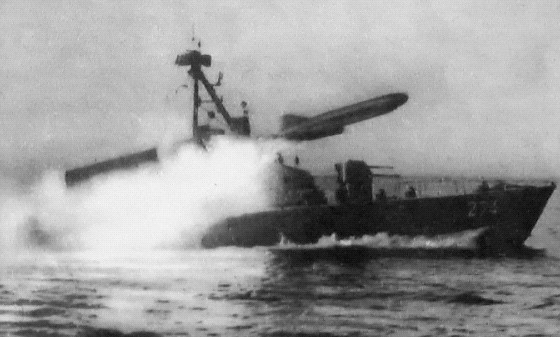
The world’s first Fast Attack Crafts: USSR in the early cold war was resolutely embracing innovation to compensate for its numerical inferiority: The Komar class FACs, using antiship missiles, was one such solutions.
The Soviet Navy in its post-Stalin era resolutely was not strong strong on the conventional side to compete with NATO and their combined forces. One way to do reverse the balance was through missiles, included in green water navy, more defensive an coastal stance, a cheap and efficient way to attack ships at distance of safety at an age of radars (something MTBs could not longer do) was to simply swap torpedoes for Missiles.
The Soviet Navy was the first to do this. And its traduction became the Komar class, the first Fast Attack Craft (FAC). The latter denomination presupposed with missiles, to make a difference with classic MTBs. This was only possible thanks to the development of a missile: The P-15 Termit (SS-N-2 “Styx”), giving a reach of 80 kilometres (50 mi), unheard of for torpedo-carrying MTBs. The latter was soon found obsolete, despite the fact, the Soviet Navy had one of the most impressive fleet of such vessels at its disposal.
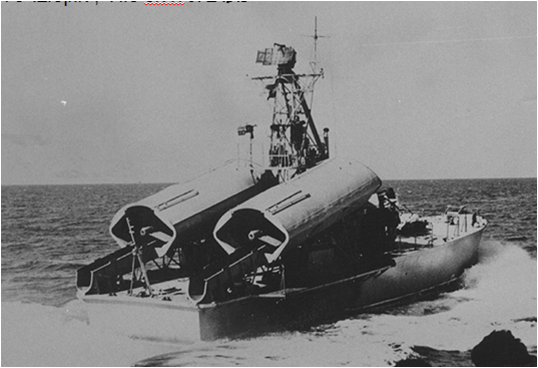
An Egyptian Komar boat patrolling off Suez in 1975
The Komar also became an export success, understandably, giving some navies on paper a cheap way to deal with much more massive ships, such as destroyers, frigates and cruisers. The Soviet Navy reinvented asymetric warfare, a century almost after the invention of the torpedo. Built by the hundreds (for USSR, Warsaw pact satellites and China under licence), this FAC was extremely popular and served well until the end of the cold war, notwithstanding the fact the P-15 Termit was totally rendered obsolete by new chaffs, ECMs, jamming, rapid firing guns and limited in its accuracy due to primitive optics and guidance systems.
Overview: From Soviet MTBs to FACs
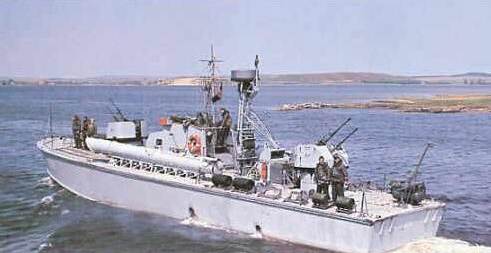
A Chinese PLAN P6 class MBT, closely derived from the Soviet one.
Since it was defined by Stalin in its first five-year naval plan, the Soviet Navy was in no shape for conventional blue water naval warfare and had to concentrate on coastal defence instead as a priority. Only by the last plan before the war, the Soviet Navy underwent the construction of battleships and other ambitious vessels.
In the meantime, it concentrated on smaller vessels, in particular submarines with the largest fleet worldwide in 1939. The other, way cheaper alternative to submersibles was of course torpedo-boats, in their modernized form called motor torpedo boats (in Russian моторные торпедные катера) such as the Sh-4, G-5 and D3 class.
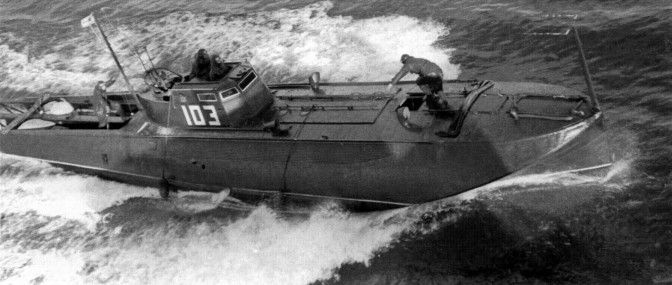
The wartime G5 class was basically derived from the MAS design, with rear-launched torpedoes. They gave mixed results. Postwar, after the P4, the admiralty desired a much larger, more versatile platform.
In the same manner after the death of Stalin in 1953, the head of the navy was entrusted by premier Nikita Khrushchev to cut down previous passive plans for conventional cruisers, and battlecruisers, to concentrate on innovation instead. One of these fields was of course missiles. This was achieved in 1956 with the introduction of the P-15 Termit antiship missile.
The rest was left to find a proper, cheap way to dispense the missile. The Soviet Navy then regarded the Proyekt 183 MTB, first designed in 1945 and already produced to more than 600 vessels, as a solid, trusted platform. It did not derived from the rather small 1945 P4, Project 123 bis (and variants M123 bis and 123K Komsomolec), already produced until 1951 to 349 units.
This 22 tonnes boat was derived in direct line from the P3 and G3, standard wartime MTBs scaled on the Italian MAS (which the Italians provided in the interwar). The new P6 was to be much larger, modelled after the more versatile British Fairmile and American Elco type MTBs.
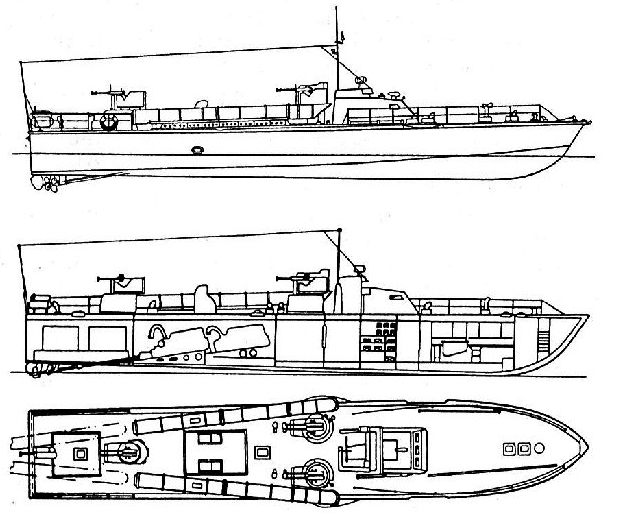
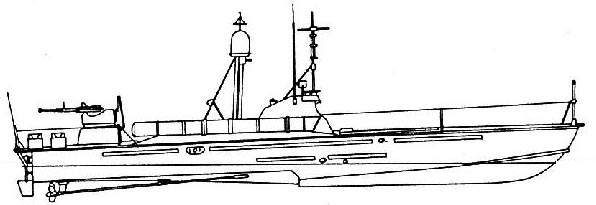
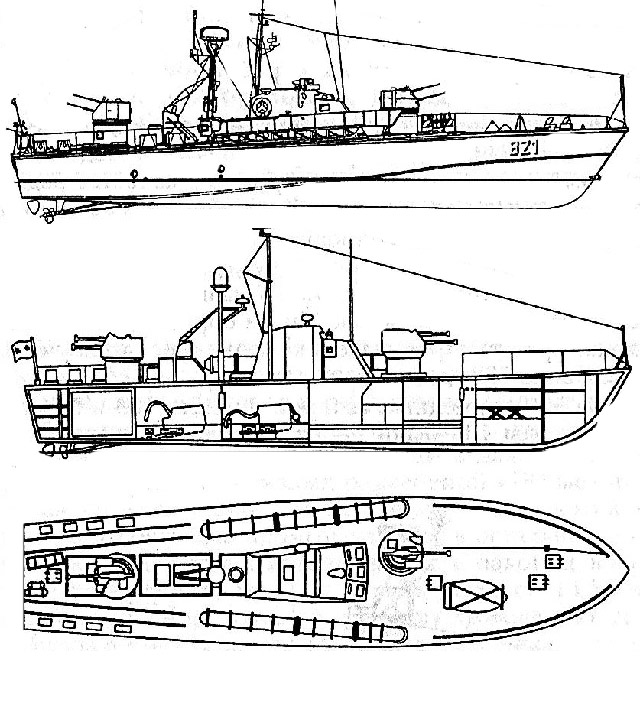
P2 (Projekt 200), P4 (123K) and P6-P10 (Projekt 183) diagrams. Credits: warboats.org
The P6 and derived P8 and P10 were 66.5 tonnes vessels (fully loaded), powered by four diesels for a combined output of 4800 bhp, giving a top speed of 44 knots (two more than the P4) but moreover a 1000 nm range at 14 knots, as compared to only 400 for the P4. This made them better suited for long coastal patrols, and led the admiralty to decline the type to a submarine-chaser, called the MO-VI (Proyekt 199), with minimal modifications and a sonar Tamir-10 they entered service in 1955, 60 built. with a grand total, all combined, of 674 vessels built until.
Design of the Komar class
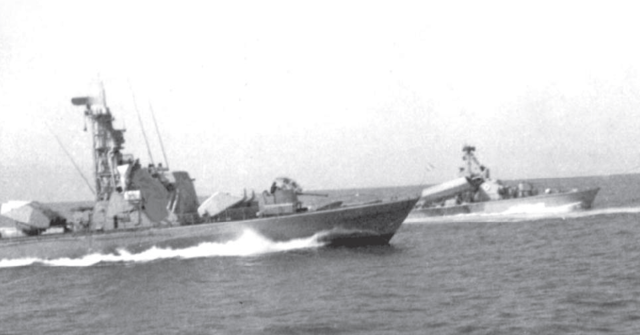
The “Mosquito” class (Komar) was designed with a range of 800 nautical miles at 25 knots or to be able to run at 30 knots over 400 nautical miles for the final approach or escape. This was far greater than previous models. The “Styx” (NATO denomination) missile added an extra range of 18 miles. Its 1100-pound conventional warhead was sufficient if detonated just above the waterline to break the hull.
ALMAZ was responsible for the final design. The initial base for the project called 183R (“R” for “Raketa”). In compliance with new, higher requirements of the Navy, weaponry, navigability and operational capabilities dictated the used of a steel hull. The results of performed scientific and engineering, plus full-scale tests were related to the 205 project.
General characteristics
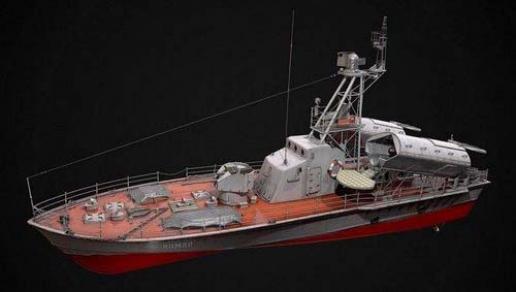
The Komar class was narrowly derived from the standard Soviet motor boat M6 – Project 183. It had the same wooden semi-planing hull which allowed scale economy. It was a sound, flexible, light yet solid package, reliable and durable at the same time. The originl Type 183 had two 533 mm (21 in) side cradles torpedo tubes and two reloads and were roomy enough to carry also two 25 mm guns. It was closely derived itself from the P 4 class torpedo boat with an aluminium hull.
The P 6-class also called “Project 183 Bolshevik” served alongside the P 4 and came with or without radar (183T and 183). The P 6 was much larger than the P 4-class with thrice the displacement and much more heavily armed. The passeage from 18-in to 21-in torpedoes plus twin 25 mm gun mounts instead 14.5 mm gun mounts were indeed quite an improvement.
For the 184R the hull was strengthened at the rear, the TT eliminated, the 25 mm mounts changes slightly and two massive cradle/launchers for the P15 Termit installed installed at the rear, behind and abaft the bridge. Both launchers pointed outwards from the axis and two steps were overhanging of the sides over the hull behind the launchers. The rear deck of course was devoid of all superstructure and treated for the blast.
Powerplant
The powerplant was of course much larger than on the P4, and the same between models (apart the P10): Four Zvezda M-50F diesels, 62 liters V12. They developed 4,800 hp (3,600 kW) combined, each driving a shaft. The model is relatively “light” compared to the later famous Zvezda M503 used on the Osa class FACs. The latter indeed were derived from the M501 developed for cancelled strategic bombers; The M503 developed 4,000 hp and the M-504B 5,000 hp.

Extract from a video – starting a Zvezda M-50F3 1200 hp diesel.
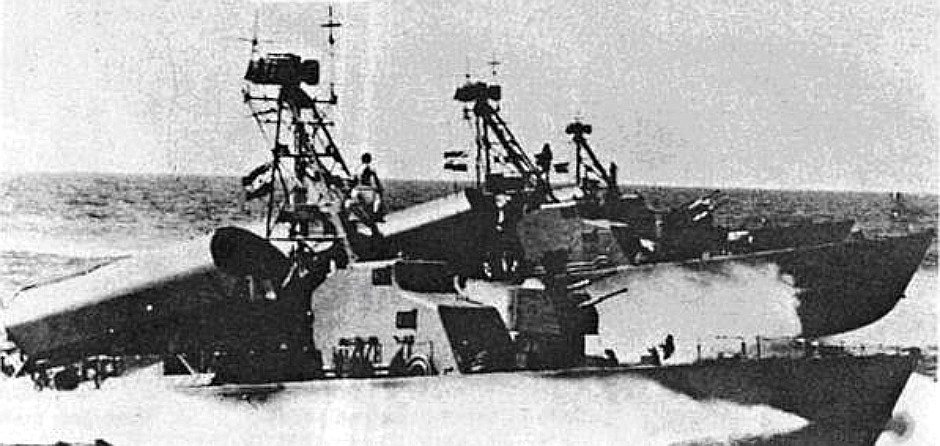
Armament
The Komar class was armed by two missiles, with no reloads, and two twin 25 mm AA guns.
Missiles: The P-15 Termit
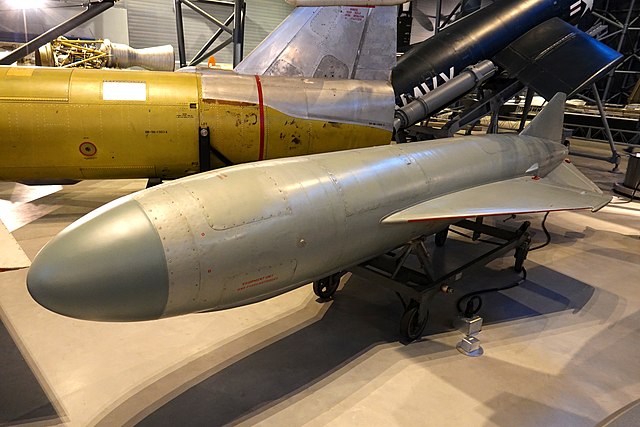
Specifications:
The P15 termit weighted 2,580 kg (5,690 lb), for 5.8 m (19 ft) x 0.76 m (2 ft 6 in) Wingspan 2.4 m
It carried a warhead with a 454 kg (1,001 lb) conventional hollow charge HE
Its Engine had a liquid-propellant rocket and solid-propellant rocket booster
Operational range: 80 kilometres (50 mi)
Flight altitude: 25-100 metres (82 to 328 ft)
Speed: Mach 0.95
Guidance system: autopilot (inertial guidance), active radar homing, infrared homing
Outside the Komar class, this model (also massively used by China), was used on the Osa, Tarantul, Nanuchka, Koni, Kotor, Kildin, and Kashin classes.
The SS-N-2 system in Soviet concept of operations, called aircraft or other ships to locate the target and direct attacking patrol boats, until they can pick up the target on their radars. The radar detection range was the same on the Osa and Komar limited in height, to about 20 miles.
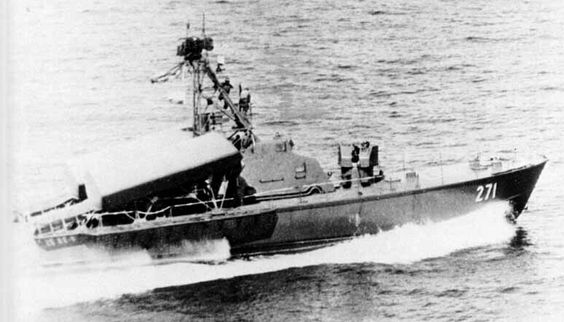
The Komar radar was used to locate the target, and provide firing datato the missile. It could also assess the damage after the attack. The effective range was in theory extensible by the coastal radar and provide detection and location. The missile could also be aimed based on the data provided by the optical system, used as a backup.
The rocket booster propelled the missile out of the launcher and allowed the missile to step to its standard cruise altitude and speed. The flight at Mach 0.9 and altitude between 300 and 1,000 feet and lower altitude on the final run, leaving only a minute to defending forces to react.
Of course, attacking the patrol boats themselves before their launching area was the only solution, if detected soon enough ans a missile sent to destroy them. But after launch, the missile’s own speed, low flight altitude and small radar cross-section plus its built-in electronic countermeasures system made it efficient for the time. In addition they could be fired in sea state 4.
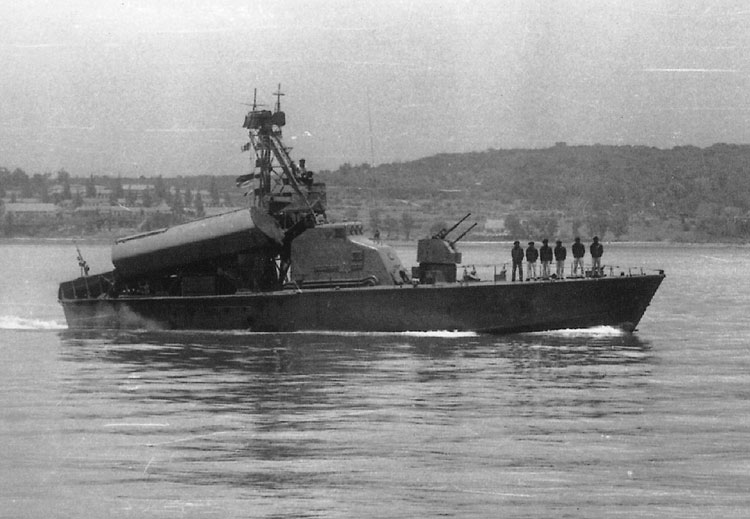
Of course on the long run as technology went, it was found obsolete quite quickly. Targets too close, beyond five miles, cannot be engaged due to the missile slow homing and arming mechanism, and activation. Also in case two targets were detected, the homing radar could not give a priority target and was sensible to electronic countermeasures. The radar was known also to suffer extreme weather, below 4°F or above 104°F. Also the missiles were not efficient for targets four miles offshore due to the “clutter” ground reflection on the homing radar.
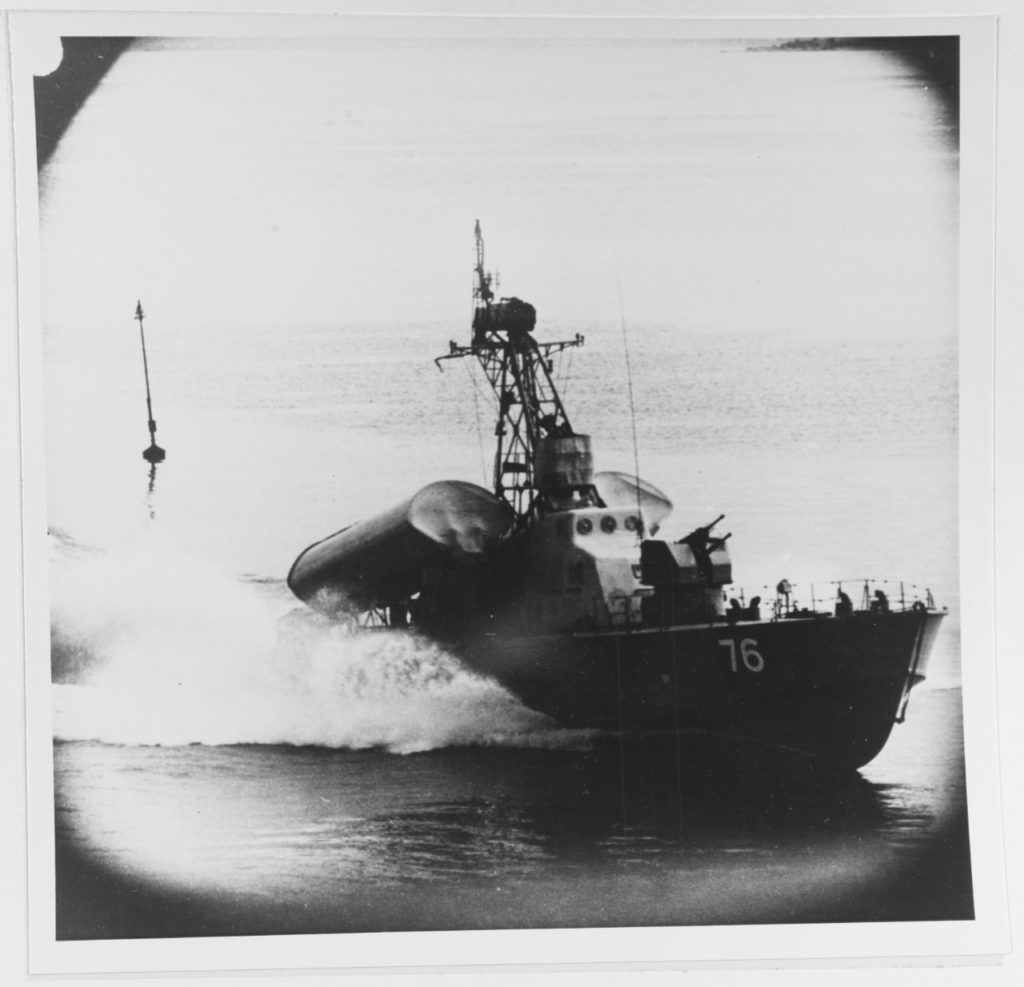
25 mm
These were 2M3-M 25mm/38 guns in two twin gun mounts (and 1,000 rounds in store), fore and aft of the bridge.
Based on the 84-KM of WW2, it was developed in 1945, until 1947. Trials started from 1949, with acceptation in service in 1953. The version was called 110-PM manufacturerd until 1984.
They were were fed by 65-round belts or 7-round clips for earlier models. It was particular as haviing both mount on on top of the other. Designated as 2M-3, it was modified and upgraded as 2M-3M for the Komar boats. These were converted to gas-operation and their firing rate increased to 470 – 480 rpm. They were cooled by running seawater during 15 seconds during reloads sessions.
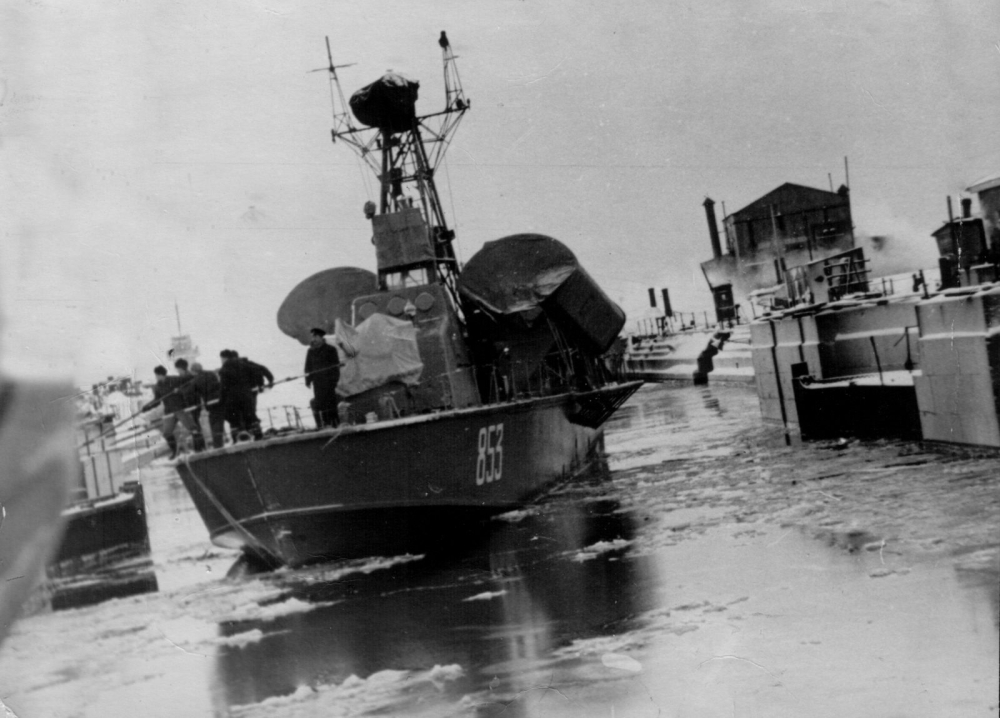
Komar boat – src military edge
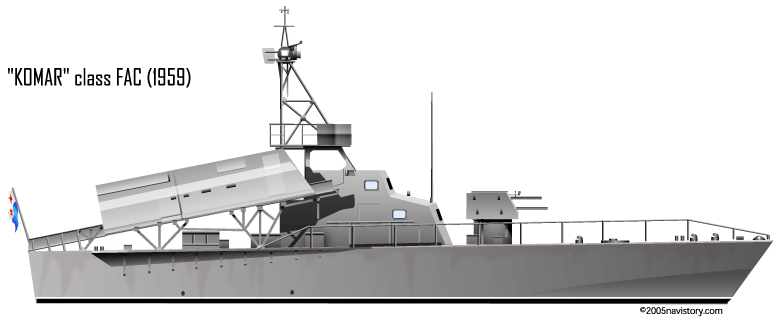
Author’s vectorial rendition of the Komar class
Specifications |
|
| Dimensions | 25.4 x 6.24 x 1.24m (83.4 x 20.6 x 4 ft) |
| Displacement | 61.5 standard 66.5 tonnes FL |
| Crew | 17 |
| Propulsion | 4 shaft M-50F diesels 4,800 hp (3,600 kW) |
| Speed | 44 knots (81 km/h; 51 mph) |
| Range | 600 nmi (1,100 km; 690 mi) at 32 knots |
| Armament | 2 SS-N-2 Styx SSNs, 2×4 25 mm AA 2M-3M |
| Electronics | MR-331 Rangout radar, Nikhrom IFF |
Production and variants
The Komar in service
Cuban missile crisis – 1962
Operation “Anadyr” saw the Soviet Navy privide Cuba some eight Komar-class boats, whereas a provision of missiles was carried by ships. They stayed in Cuban water all along the crisis, but could not operate as beyond the exclusion zone. USN presence however was deterred from approaching coastal waters because of their presence. They guaranteed any new attmpt of a landing like the ill-fated bay of pigs operation.
War of attrition – 1967
In October 1967, the Israeli destroyer Eilat was destroyed by ‘Styx’ anti-ship missiles, from Egyptian Komar class ships. The event was an excellent adverstising for USSR which signed dozens of exports of Komar and Osa type boats. They proliferated in the navies of the Warsaw Pact and Soviet client states.
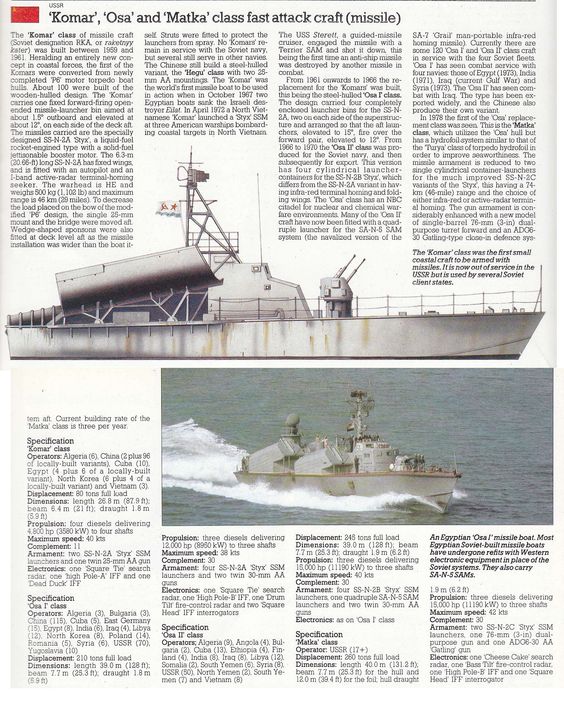
This was a world’s first, for a surface-to-surface antiship missile; This 21 October 1967 Egyptian Komar class ships (and some Osa vessels) spotted the Israeli destroyer Eilat off Port Said. They fired several SS-N-2 missiles which left little chance to the big stationary target that was the ancient British-built, WW2 generation destroyer. Several hits blasted the hull and she sank rapidly.
Eilat was patrolling Egyptian coast to prevent maritime infiltration of the Sinai. She did so, like many other Israeli vessels within the range of Egyptian defense since June. Eilat already went into the area several times. The atack came as a true surprise, and when hit, Eilat was estimated just on the fringe of the 12—mile territorial limit claimed by Egypt.
The Israeli crew knew of the impending attack as they were spotted by land-based Egyptian radars, but failed to detect any FAC. When 3-4 missiles were flying towards her, at last the ships were spotted at about six miles. Gunners tried to shoot down the incoming missiles, but to no avail.
Hit by two missilees, Eilat was totally disabled and after power died out, and floated dead in the water for nearly two hours. The crew tried to save her when a second attack came, and this time the thred and possibly fourth hit made her sinking.
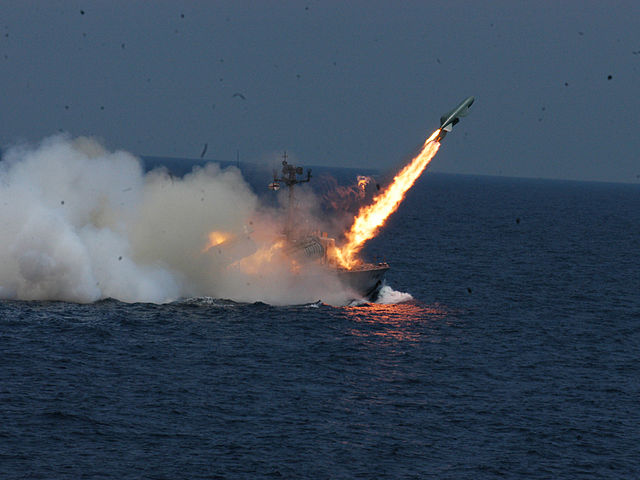
Vietnam War – 1967-73
Chinese Osa boats have been seen in the South China Sea and were deployed from the Hainan Island, down to the Tonkin Gulf area. They never intervened furing the war. No Soviet or Chinese boat was delivered to the North Vietnamese either. The USN fleet was vulnerable to sneak attack. RVN boats could be dispersed between many islands and waterways along the coastline. Difficult to detect (compounded by the fact the Vietnamese were aces of camouflage) they even can masquerade to observer by sailing in the fleet of innoffensive fishing junks. The only incident, on USS Maddox was performed by three P4 class TBs on 2 august 1964.
Yom Kippur War – 1973
P-15 missiles were used by the Egyptian and Syrian navies, but they proved ineffective against the Israeli navy. The latter operated a serie of brand new, modern Sa’ar-class FACs which were faster, smaller, more agile and better armed with excellent countermeasures than their opponents.
Nevertheless, the range of the P-15 was two times higher than the IAI Gabriel, allowing to fire first. But radar jamming/chaff/ECM degraded their accuracy. The Battle of Latakia and Battle of Baltim, saw several dozen P-15s fired, without result. In addition the arab ships had smaller guns compared to their Israeli opponents.
Exports
Starting in the 1960s already when new models were about to enter service, and export production, the Soviet Navy provided the Komar, a best-seller due to its unique anti-ship capability for the time, to many navies, from its enlarge network and emergent third world countries. Gradually, the entire serie was sold. Probably the most famous operational use was by the Egyptian Navy, by far (see later). China became the sescond largest user of the type, building a very large serie locally.
Algerian National Navy: 6 boats (1967)
People’s Liberation Army Navy: 8 boats (1961), 40 more under licence and steel hulled derivative Type 024 FAC.
Cuban Revolutionary Navy: 18 boats (1965?)
Egyptian Navy: 7 purchased in 1962–67. BU 1990s. 6 derived boats with western weapons and electronics: October class.
Indonesian Navy: 12 boats (1961–65)
Iraqi Navy: 3 boats (1972)
Myanmar Navy: 6 boats donated 1969-1974, last retired 2002.
Korean People’s Army Naval Force: 10 boats
Syrian Arab Navy: 9 boats
Vietnam People’s Navy: 4 boats
Conclusion
The Komar (“mosquito”, project 183R) will remain as the first missile launchers in the world. Developed from standard hulls type 183, already available on torpedo boats of types P6, P8 and P10, just after the war, themselves developed from the P4K or “Komsomolec” of 1944. These stars of a new genre were to deploy the first Soviet anti-ship missiles, the P15 “Styx” (SSN-2).
Development work started in 1957 and focused on the SSN-1 (P14). The missile launcher version was quickly developed and in December 1959 and the first of 112 Komar class units was built in 1956. In addition to these two formidable missiles they carried two 25 mm twin mounts and a “Square Tie” radar. The first tests were carried out in the Black Sea via a command ship, by remote-controlled fire such was feared the effects of a takeoff of these large missiles on small hull.
Nevertheless, the Komar class were intensively evaluated and became able to fire their missiles in an already very rough sea (force 4), in a calm sea reaching 38 knots, allowing rapid deployment, but suffering from a certain overload.
These ships quickly became very popular for their affordable, yet formidable firepower: Many of the exports, starting early, were dictated by the arrival of a larger moderl, the Osa class.
Read More/Src
Conway’s all the world’s fighting ships 1947-95
http://russianships.info/eng/warfareboats/project_183r.htm
https://www.globalsecurity.org/military/world/russia/183r.htm
https://www.kchf.ru/eng/ship/warfarecorvettes/rk14.htm
http://www.navypedia.org/ships/korea_north/kon_cf_183r.htm
Couhat Jean. Combat Fleets of the world 1982/1983
https://www.usni.org/magazines/naval-history-magazine/2008/october/cruise-missile-comes-age
Project 183 MTB rendition https://warthunder.com/en/news/4198-development-project-183-bolshevik-torpedo-boat-speed-and-power-en/
http://urbanpk.com/pakdef/pakmilitary/navy/hokuclass_imb.html
http://www.hisutton.com/List%20of%20Warships%20sunk%20by%20sneak%20attack.html
3D Corner:
EV Models resin Komar class Missile boats (2 sets) with SS-N-2 “Styx” S047 1/700

 Latest Facebook Entry -
Latest Facebook Entry -  X(Tweeter) Naval Encyclopedia's deck archive
X(Tweeter) Naval Encyclopedia's deck archive Instagram (@navalencyc)
Instagram (@navalencyc)





 French Navy
French Navy Royal Navy
Royal Navy Russian Navy
Russian Navy Armada Espanola
Armada Espanola Austrian Navy
Austrian Navy K.u.K. Kriegsmarine
K.u.K. Kriegsmarine Dansk Marine
Dansk Marine Nautiko Hellenon
Nautiko Hellenon Koninklije Marine 1870
Koninklije Marine 1870 Marinha do Brasil
Marinha do Brasil Osmanlı Donanması
Osmanlı Donanması Marina Do Peru
Marina Do Peru Marinha do Portugal
Marinha do Portugal Regia Marina 1870
Regia Marina 1870 Nihhon Kaigun 1870
Nihhon Kaigun 1870 Preußische Marine 1870
Preußische Marine 1870 Russkiy Flot 1870
Russkiy Flot 1870 Svenska marinen
Svenska marinen Søværnet
Søværnet Union Navy
Union Navy Confederate Navy
Confederate Navy Armada de Argentina
Armada de Argentina Imperial Chinese Navy
Imperial Chinese Navy Marinha do Portugal
Marinha do Portugal Mexico
Mexico Kaiserliche Marine
Kaiserliche Marine 1898 US Navy
1898 US Navy Sovietskiy Flot
Sovietskiy Flot Royal Canadian Navy
Royal Canadian Navy Royal Australian Navy
Royal Australian Navy RNZN Fleet
RNZN Fleet Chinese Navy 1937
Chinese Navy 1937 Kriegsmarine
Kriegsmarine Chilean Navy
Chilean Navy Danish Navy
Danish Navy Finnish Navy
Finnish Navy Hellenic Navy
Hellenic Navy Polish Navy
Polish Navy Romanian Navy
Romanian Navy Turkish Navy
Turkish Navy Royal Yugoslav Navy
Royal Yugoslav Navy Royal Thai Navy
Royal Thai Navy Minor Navies
Minor Navies Albania
Albania Austria
Austria Belgium
Belgium Columbia
Columbia Costa Rica
Costa Rica Cuba
Cuba Czechoslovakia
Czechoslovakia Dominican Republic
Dominican Republic Haiti
Haiti Hungary
Hungary Honduras
Honduras Estonia
Estonia Iceland
Iceland Eire
Eire Equador
Equador Iran
Iran Iraq
Iraq Latvia
Latvia Liberia
Liberia Lithuania
Lithuania Mandchukuo
Mandchukuo Morocco
Morocco Nicaragua
Nicaragua Persia
Persia San Salvador
San Salvador Sarawak
Sarawak Uruguay
Uruguay Venezuela
Venezuela Zanzibar
Zanzibar Warsaw Pact Navies
Warsaw Pact Navies Bulgaria
Bulgaria Hungary
Hungary

 Bundesmarine
Bundesmarine Dutch Navy
Dutch Navy Hellenic Navy
Hellenic Navy Marina Militare
Marina Militare Yugoslav Navy
Yugoslav Navy Chinese Navy
Chinese Navy Indian Navy
Indian Navy Indonesian Navy
Indonesian Navy JMSDF
JMSDF North Korean Navy
North Korean Navy Pakistani Navy
Pakistani Navy Philippines Navy
Philippines Navy ROKN
ROKN Rep. of Singapore Navy
Rep. of Singapore Navy Taiwanese Navy
Taiwanese Navy IDF Navy
IDF Navy Saudi Navy
Saudi Navy Royal New Zealand Navy
Royal New Zealand Navy Egyptian Navy
Egyptian Navy South African Navy
South African Navy






























 Ukrainian Navy
Ukrainian Navy dbodesign
dbodesign